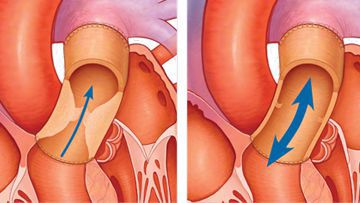Pulmonary Atresia And Pulmonary Stenosis
Dr. Ira Shah
Consultant Pediatrician, B.J.Wadia Hospital for Children, Mumbai, India
First Created: 02/05/2001
Last Updated: 08/01/2015
Show details
Patient Education
What is pulmonary atresia?
The heart consists of 4 chambers - the right and left atrium. atrium (These are the chambers that receive the blood - the right atrium receives impure blood from the rest of the body and the left atrium receives pure blood from the lungs) and the right and left ventricles (These are the chambers that pump the blood from the heart - right ventricle receives impure blood from the right atrium and sends it to the lungs and left ventricle receives pure blood from the left atrium and sends it to the body). The right atrium is separated from the right ventricle by a valve called a tricuspid valve. The left atrium is separated from the left ventricle by a valve called a mitral valve. The blood flows from the right ventricle to the lungs via the pulmonary artery is regulated by the pulmonary valve while the blood flow from the left ventricle to the rest of the body via the aorta is regulated by the aortic valve. In pulmonary atresia, no pulmonary valve exists, so blood can’t flow from the right ventricle into the pulmonary artery and on to the lungs. The tricuspid valve is often poorly developed too. Thus for the blood to go to the lungs, either blood flows from the right ventricle to the left ventricle by a hole in the ventricular wall (ventricular septal defect) or from the right atrium to the left atrium by a hole in the atrial wall (atrial septal defect). So there is a mixing of both impure blood and oxygen-rich blood on the left side of the heart. The left ventricle pumps this mixture of blood into the aorta and the rest of the body. Part of the blood from the aorta is sent to the lungs through a connection between the aorta and the pulmonary artery called patient ductus arteriosus (PDA). This blood then gets oxygen in the lungs and comes back to the left atrium.
What are the symptoms of pulmonary atresia?
As there is a mixing of both oxygen-rich and oxygen-poor blood which goes into the body, the baby may appear blue because there is less oxygen in the blood circulating in the arteries.
What is the treatment of pulmonary atresia?
Since PDA is essential to allow blood flow to the lungs, early treatment is often required to prevent PDA from closing. A shunt between the aorta and the pulmonary artery is required to increase blood flow to the lungs and promote the growth of pulmonary arteries. Complete repair may be done at a later date to connect the right ventricle to the pulmonary artery by a conduit. If the right ventricle is very small, then the right atrium may be directly attached to the pulmonary artery. The ASD or VSD are also closed at the same time.
1. Pulmonary atresia with ventricular septal defect: Systematic review, D. Balaguru et al.
2. Pulmonary atresia with intact ventricular septum: Menagement options and decision-making, H. Burkholder et al.
3. Does mild pulmonary stenosis progress during childhood? A study of its natural course, J Ardura et al.
 Dr. Ira Shah
Pulmonary Atresia and Pulmonary Stenosis
https://www.pediatriconcall.com/show_article/default.aspx?main_cat=pediatric-cardiology&sub_cat=pulmonary-atresia-and-pulmonary-stenosis&url=pulmonary-atresia-and-pulmonary-stenosis-patient-education
2015-08-01
2015-08-01
Dr. Ira Shah
Pulmonary Atresia and Pulmonary Stenosis
https://www.pediatriconcall.com/show_article/default.aspx?main_cat=pediatric-cardiology&sub_cat=pulmonary-atresia-and-pulmonary-stenosis&url=pulmonary-atresia-and-pulmonary-stenosis-patient-education
2015-08-01
2015-08-01
×
Contributor Information and Disclosures
Dr. Ira Shah
Consultant Pediatrician, B.J.Wadia Hospital for Children, Mumbai, India
First Created: 02/05/2001
Last Updated: 08/01/2015
×
References
1. Pulmonary atresia with ventricular septal defect: Systematic review, D. Balaguru et al.
2. Pulmonary atresia with intact ventricular septum: Menagement options and decision-making, H. Burkholder et al.
3. Does mild pulmonary stenosis progress during childhood? A study of its natural course, J Ardura et al.